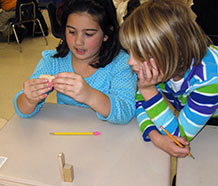How can centimeter cubes help us measure volume?
2. Place four blocks in a volume line

Explore and Estimate: Give students about 5 minutes to explore the blocks and to range them on a volume line from “Least volume” to “Most volume.” They will quickly discover that this exercise is harder than the last one, for the volumes of the blocks are very similar.
As you circulate among the groups, ask how they are making their decisions and encourage students to think about how they might actually measure the volumes. As each group comes to consensus, have a volunteer record the order in the class table. Students should also record their order in their notebooks.

When the table is complete, ask the class to study it. Do they see any patterns? Does everyone agree which cube has the greatest volume? The least volume? Did the groups use different strategies? Where are there differences of opinion? Acknowledge that the task is hard, and let students know that it’s OK to disagree because these are “guesstimates,” not measurements.
Similar volumes: The volumes of three of the blocks are intentionally similar (or the same). As in Investigating Weight Investigation 1 (when the students tried to distinguish similar weights using only their senses), the point is to establish the value of having a measuring system that is precise and controlled.
- Does anyone have any more ideas about how we might measure volume?
| Least volume | Next | Next | Most volume | |
|---|---|---|---|---|
| Group 1 Order | ||||
| Group 2 Order | ||||
| Group 3 Order | ||||
| Group 4 Order | ||||
| Group 5 Order | ||||
| Measured Order* |
* The data for “Measured Order” will be filled in during Step 4.
The volume order of the cubes from least to most is C, A, D, B or C, D, A, B. The volume of Block C is 10 cubic centimeters. The volume of Blocks A and D is 18 cubic centimeters. The volume of Block B is 20 cubic centimeters.



